Project Proposal: English Language Education for Refugees in Australia
VerifiedAdded on 2022/11/18
|11
|3462
|144
Project
AI Summary
This project proposal outlines a comprehensive plan to provide English language education to refugees in Australia, funded by the Victoria State Government. The project addresses the need for English language proficiency among refugees to facilitate social integration, improve livelihood opportunities, and contribute to sustainable development goals. It details the project's rationale, including the challenges faced by refugees in accessing education and the importance of English language skills for overcoming barriers. The project's implementation strategy involves planning, surveying, development of educational resources, and a sign-off phase. Stakeholders include the Victoria State Government, training staff, refugees, and partner organizations like Foundation House, Languages and Multicultural Education Resource Centre, Refugee Council of Australia, and NSW Department of Education and Communities. The project's success will be monitored through surveys, questionnaires, and self-assessment tools, with the goal of improving the refugees' English language skills and overall quality of life. The project's sustainability is ensured through ongoing technical support from the Victoria State Government.

1. Project information
Project title Providing English language Education to refugees
Duration in months: 24
Total funding
requested
400 thousand Australian Dollar
Donor/Funding
Source
In the case of the present project, it can be discussed that the Victoria State
Government has a rich experience to think about new ideas and practices
based on providing English language education to the migrants and
refugees. Hence, they would fund for the entire project.
1
Project title Providing English language Education to refugees
Duration in months: 24
Total funding
requested
400 thousand Australian Dollar
Donor/Funding
Source
In the case of the present project, it can be discussed that the Victoria State
Government has a rich experience to think about new ideas and practices
based on providing English language education to the migrants and
refugees. Hence, they would fund for the entire project.
1
Paraphrase This Document
Need a fresh take? Get an instant paraphrase of this document with our AI Paraphraser
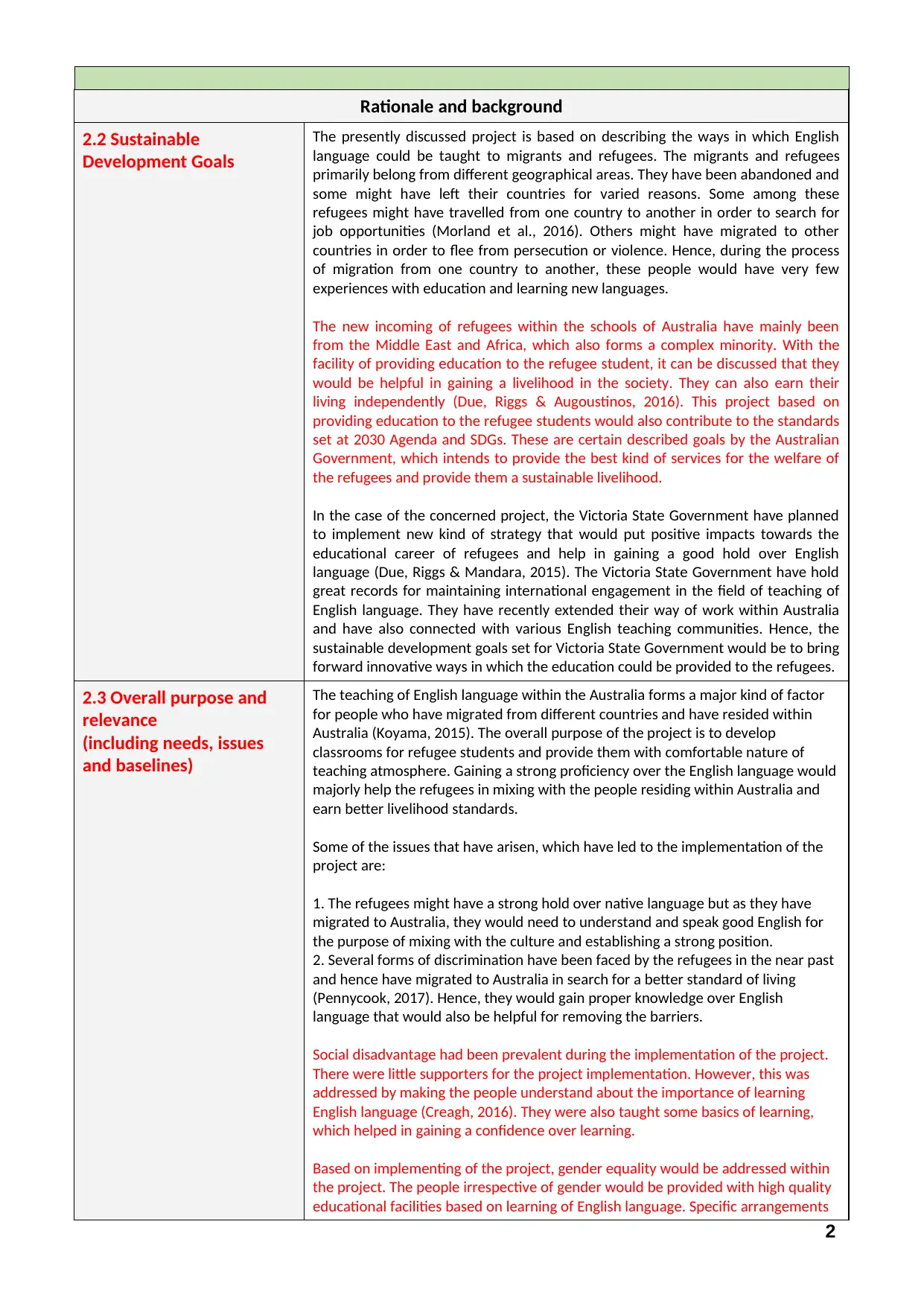
Rationale and background
2.2 Sustainable
Development Goals
The presently discussed project is based on describing the ways in which English
language could be taught to migrants and refugees. The migrants and refugees
primarily belong from different geographical areas. They have been abandoned and
some might have left their countries for varied reasons. Some among these
refugees might have travelled from one country to another in order to search for
job opportunities (Morland et al., 2016). Others might have migrated to other
countries in order to flee from persecution or violence. Hence, during the process
of migration from one country to another, these people would have very few
experiences with education and learning new languages.
The new incoming of refugees within the schools of Australia have mainly been
from the Middle East and Africa, which also forms a complex minority. With the
facility of providing education to the refugee student, it can be discussed that they
would be helpful in gaining a livelihood in the society. They can also earn their
living independently (Due, Riggs & Augoustinos, 2016). This project based on
providing education to the refugee students would also contribute to the standards
set at 2030 Agenda and SDGs. These are certain described goals by the Australian
Government, which intends to provide the best kind of services for the welfare of
the refugees and provide them a sustainable livelihood.
In the case of the concerned project, the Victoria State Government have planned
to implement new kind of strategy that would put positive impacts towards the
educational career of refugees and help in gaining a good hold over English
language (Due, Riggs & Mandara, 2015). The Victoria State Government have hold
great records for maintaining international engagement in the field of teaching of
English language. They have recently extended their way of work within Australia
and have also connected with various English teaching communities. Hence, the
sustainable development goals set for Victoria State Government would be to bring
forward innovative ways in which the education could be provided to the refugees.
2.3 Overall purpose and
relevance
(including needs, issues
and baselines)
The teaching of English language within the Australia forms a major kind of factor
for people who have migrated from different countries and have resided within
Australia (Koyama, 2015). The overall purpose of the project is to develop
classrooms for refugee students and provide them with comfortable nature of
teaching atmosphere. Gaining a strong proficiency over the English language would
majorly help the refugees in mixing with the people residing within Australia and
earn better livelihood standards.
Some of the issues that have arisen, which have led to the implementation of the
project are:
1. The refugees might have a strong hold over native language but as they have
migrated to Australia, they would need to understand and speak good English for
the purpose of mixing with the culture and establishing a strong position.
2. Several forms of discrimination have been faced by the refugees in the near past
and hence have migrated to Australia in search for a better standard of living
(Pennycook, 2017). Hence, they would gain proper knowledge over English
language that would also be helpful for removing the barriers.
Social disadvantage had been prevalent during the implementation of the project.
There were little supporters for the project implementation. However, this was
addressed by making the people understand about the importance of learning
English language (Creagh, 2016). They were also taught some basics of learning,
which helped in gaining a confidence over learning.
Based on implementing of the project, gender equality would be addressed within
the project. The people irrespective of gender would be provided with high quality
educational facilities based on learning of English language. Specific arrangements
2
2.2 Sustainable
Development Goals
The presently discussed project is based on describing the ways in which English
language could be taught to migrants and refugees. The migrants and refugees
primarily belong from different geographical areas. They have been abandoned and
some might have left their countries for varied reasons. Some among these
refugees might have travelled from one country to another in order to search for
job opportunities (Morland et al., 2016). Others might have migrated to other
countries in order to flee from persecution or violence. Hence, during the process
of migration from one country to another, these people would have very few
experiences with education and learning new languages.
The new incoming of refugees within the schools of Australia have mainly been
from the Middle East and Africa, which also forms a complex minority. With the
facility of providing education to the refugee student, it can be discussed that they
would be helpful in gaining a livelihood in the society. They can also earn their
living independently (Due, Riggs & Augoustinos, 2016). This project based on
providing education to the refugee students would also contribute to the standards
set at 2030 Agenda and SDGs. These are certain described goals by the Australian
Government, which intends to provide the best kind of services for the welfare of
the refugees and provide them a sustainable livelihood.
In the case of the concerned project, the Victoria State Government have planned
to implement new kind of strategy that would put positive impacts towards the
educational career of refugees and help in gaining a good hold over English
language (Due, Riggs & Mandara, 2015). The Victoria State Government have hold
great records for maintaining international engagement in the field of teaching of
English language. They have recently extended their way of work within Australia
and have also connected with various English teaching communities. Hence, the
sustainable development goals set for Victoria State Government would be to bring
forward innovative ways in which the education could be provided to the refugees.
2.3 Overall purpose and
relevance
(including needs, issues
and baselines)
The teaching of English language within the Australia forms a major kind of factor
for people who have migrated from different countries and have resided within
Australia (Koyama, 2015). The overall purpose of the project is to develop
classrooms for refugee students and provide them with comfortable nature of
teaching atmosphere. Gaining a strong proficiency over the English language would
majorly help the refugees in mixing with the people residing within Australia and
earn better livelihood standards.
Some of the issues that have arisen, which have led to the implementation of the
project are:
1. The refugees might have a strong hold over native language but as they have
migrated to Australia, they would need to understand and speak good English for
the purpose of mixing with the culture and establishing a strong position.
2. Several forms of discrimination have been faced by the refugees in the near past
and hence have migrated to Australia in search for a better standard of living
(Pennycook, 2017). Hence, they would gain proper knowledge over English
language that would also be helpful for removing the barriers.
Social disadvantage had been prevalent during the implementation of the project.
There were little supporters for the project implementation. However, this was
addressed by making the people understand about the importance of learning
English language (Creagh, 2016). They were also taught some basics of learning,
which helped in gaining a confidence over learning.
Based on implementing of the project, gender equality would be addressed within
the project. The people irrespective of gender would be provided with high quality
educational facilities based on learning of English language. Specific arrangements
2
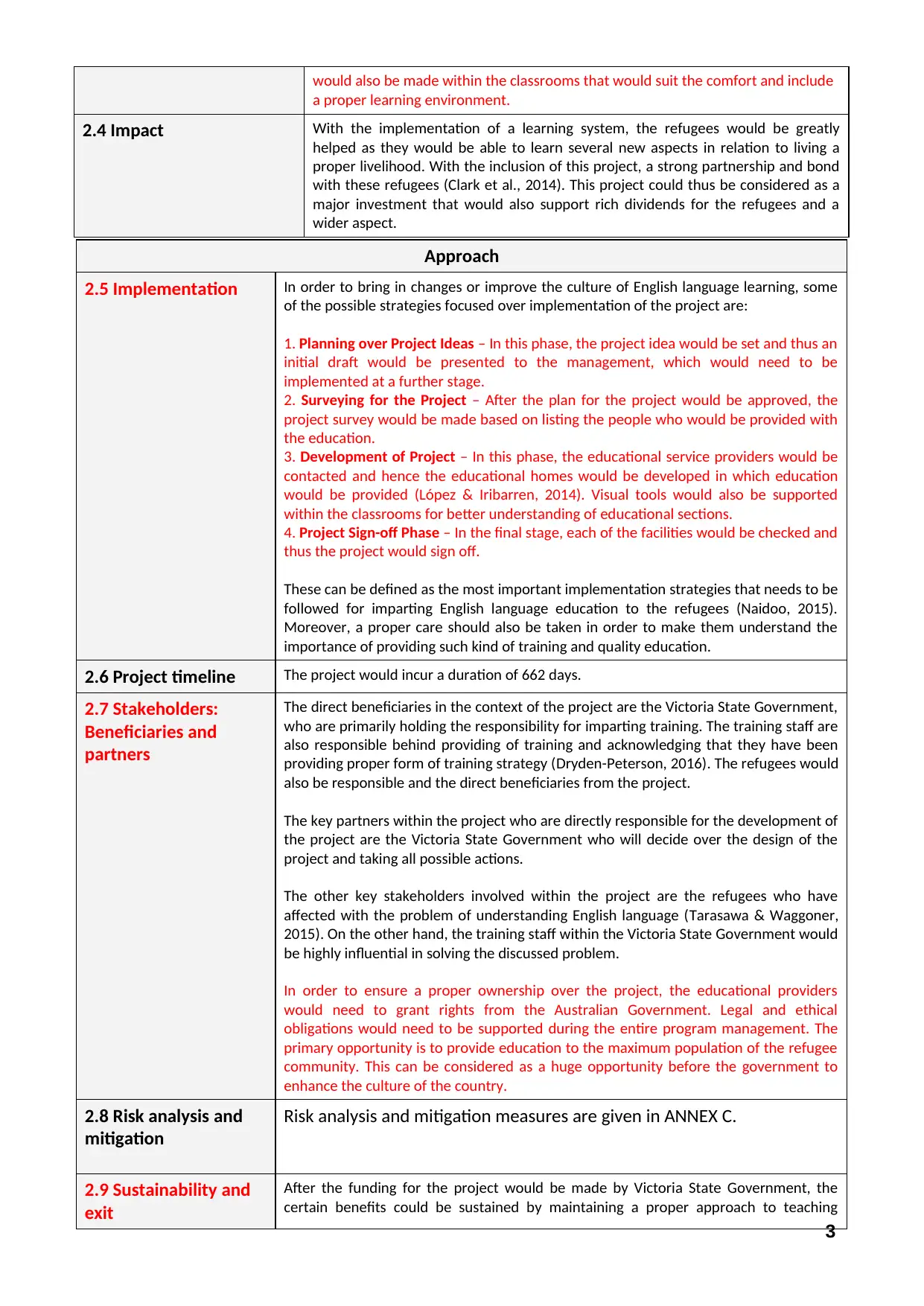
would also be made within the classrooms that would suit the comfort and include
a proper learning environment.
2.4 Impact With the implementation of a learning system, the refugees would be greatly
helped as they would be able to learn several new aspects in relation to living a
proper livelihood. With the inclusion of this project, a strong partnership and bond
with these refugees (Clark et al., 2014). This project could thus be considered as a
major investment that would also support rich dividends for the refugees and a
wider aspect.
Approach
2.5 Implementation In order to bring in changes or improve the culture of English language learning, some
of the possible strategies focused over implementation of the project are:
1. Planning over Project Ideas – In this phase, the project idea would be set and thus an
initial draft would be presented to the management, which would need to be
implemented at a further stage.
2. Surveying for the Project – After the plan for the project would be approved, the
project survey would be made based on listing the people who would be provided with
the education.
3. Development of Project – In this phase, the educational service providers would be
contacted and hence the educational homes would be developed in which education
would be provided (López & Iribarren, 2014). Visual tools would also be supported
within the classrooms for better understanding of educational sections.
4. Project Sign-off Phase – In the final stage, each of the facilities would be checked and
thus the project would sign off.
These can be defined as the most important implementation strategies that needs to be
followed for imparting English language education to the refugees (Naidoo, 2015).
Moreover, a proper care should also be taken in order to make them understand the
importance of providing such kind of training and quality education.
2.6 Project timeline The project would incur a duration of 662 days.
2.7 Stakeholders:
Beneficiaries and
partners
The direct beneficiaries in the context of the project are the Victoria State Government,
who are primarily holding the responsibility for imparting training. The training staff are
also responsible behind providing of training and acknowledging that they have been
providing proper form of training strategy (Dryden-Peterson, 2016). The refugees would
also be responsible and the direct beneficiaries from the project.
The key partners within the project who are directly responsible for the development of
the project are the Victoria State Government who will decide over the design of the
project and taking all possible actions.
The other key stakeholders involved within the project are the refugees who have
affected with the problem of understanding English language (Tarasawa & Waggoner,
2015). On the other hand, the training staff within the Victoria State Government would
be highly influential in solving the discussed problem.
In order to ensure a proper ownership over the project, the educational providers
would need to grant rights from the Australian Government. Legal and ethical
obligations would need to be supported during the entire program management. The
primary opportunity is to provide education to the maximum population of the refugee
community. This can be considered as a huge opportunity before the government to
enhance the culture of the country.
2.8 Risk analysis and
mitigation
Risk analysis and mitigation measures are given in ANNEX C.
2.9 Sustainability and
exit
After the funding for the project would be made by Victoria State Government, the
certain benefits could be sustained by maintaining a proper approach to teaching
3
a proper learning environment.
2.4 Impact With the implementation of a learning system, the refugees would be greatly
helped as they would be able to learn several new aspects in relation to living a
proper livelihood. With the inclusion of this project, a strong partnership and bond
with these refugees (Clark et al., 2014). This project could thus be considered as a
major investment that would also support rich dividends for the refugees and a
wider aspect.
Approach
2.5 Implementation In order to bring in changes or improve the culture of English language learning, some
of the possible strategies focused over implementation of the project are:
1. Planning over Project Ideas – In this phase, the project idea would be set and thus an
initial draft would be presented to the management, which would need to be
implemented at a further stage.
2. Surveying for the Project – After the plan for the project would be approved, the
project survey would be made based on listing the people who would be provided with
the education.
3. Development of Project – In this phase, the educational service providers would be
contacted and hence the educational homes would be developed in which education
would be provided (López & Iribarren, 2014). Visual tools would also be supported
within the classrooms for better understanding of educational sections.
4. Project Sign-off Phase – In the final stage, each of the facilities would be checked and
thus the project would sign off.
These can be defined as the most important implementation strategies that needs to be
followed for imparting English language education to the refugees (Naidoo, 2015).
Moreover, a proper care should also be taken in order to make them understand the
importance of providing such kind of training and quality education.
2.6 Project timeline The project would incur a duration of 662 days.
2.7 Stakeholders:
Beneficiaries and
partners
The direct beneficiaries in the context of the project are the Victoria State Government,
who are primarily holding the responsibility for imparting training. The training staff are
also responsible behind providing of training and acknowledging that they have been
providing proper form of training strategy (Dryden-Peterson, 2016). The refugees would
also be responsible and the direct beneficiaries from the project.
The key partners within the project who are directly responsible for the development of
the project are the Victoria State Government who will decide over the design of the
project and taking all possible actions.
The other key stakeholders involved within the project are the refugees who have
affected with the problem of understanding English language (Tarasawa & Waggoner,
2015). On the other hand, the training staff within the Victoria State Government would
be highly influential in solving the discussed problem.
In order to ensure a proper ownership over the project, the educational providers
would need to grant rights from the Australian Government. Legal and ethical
obligations would need to be supported during the entire program management. The
primary opportunity is to provide education to the maximum population of the refugee
community. This can be considered as a huge opportunity before the government to
enhance the culture of the country.
2.8 Risk analysis and
mitigation
Risk analysis and mitigation measures are given in ANNEX C.
2.9 Sustainability and
exit
After the funding for the project would be made by Victoria State Government, the
certain benefits could be sustained by maintaining a proper approach to teaching
3
⊘ This is a preview!⊘
Do you want full access?
Subscribe today to unlock all pages.

Trusted by 1+ million students worldwide
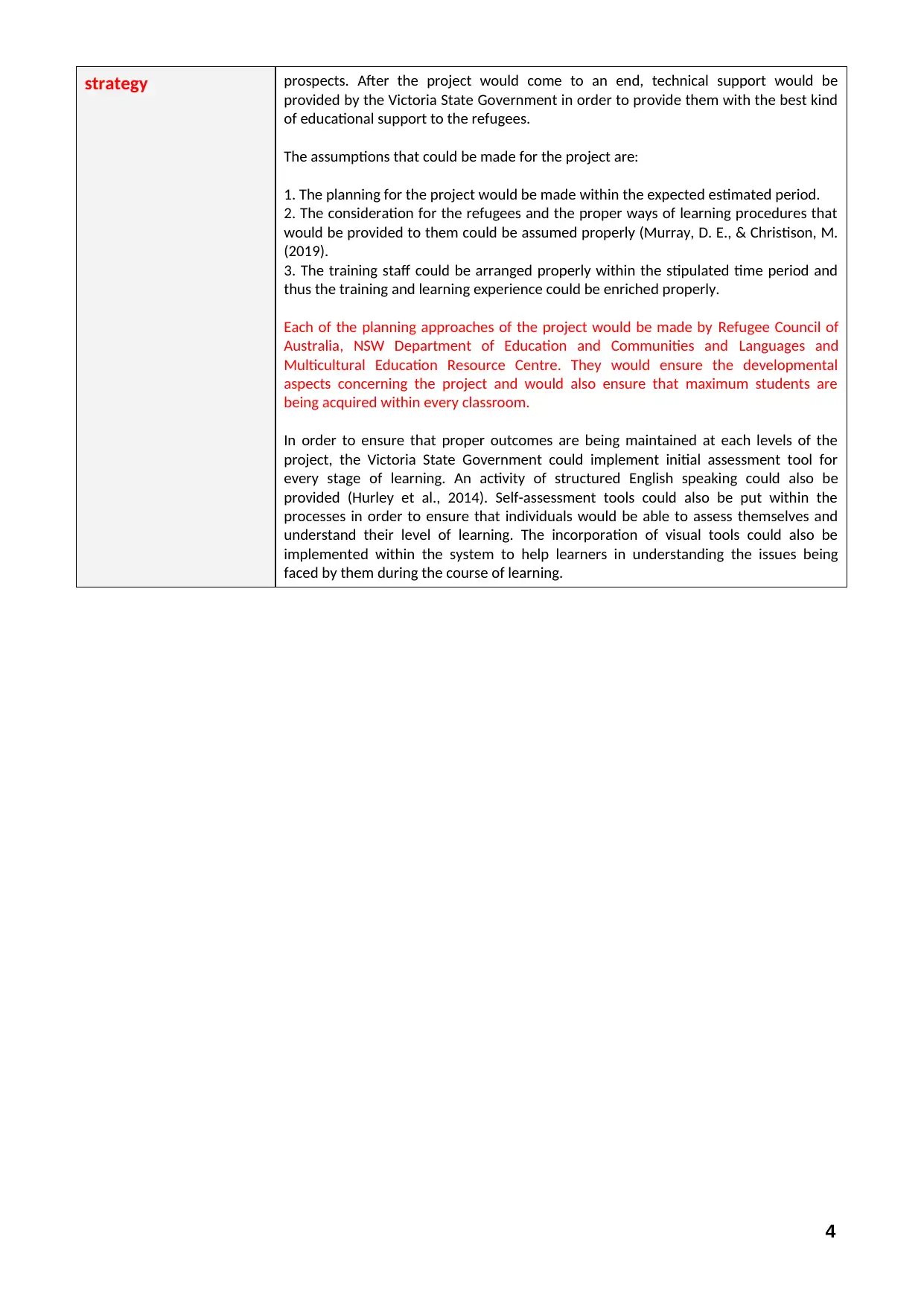
strategy prospects. After the project would come to an end, technical support would be
provided by the Victoria State Government in order to provide them with the best kind
of educational support to the refugees.
The assumptions that could be made for the project are:
1. The planning for the project would be made within the expected estimated period.
2. The consideration for the refugees and the proper ways of learning procedures that
would be provided to them could be assumed properly (Murray, D. E., & Christison, M.
(2019).
3. The training staff could be arranged properly within the stipulated time period and
thus the training and learning experience could be enriched properly.
Each of the planning approaches of the project would be made by Refugee Council of
Australia, NSW Department of Education and Communities and Languages and
Multicultural Education Resource Centre. They would ensure the developmental
aspects concerning the project and would also ensure that maximum students are
being acquired within every classroom.
In order to ensure that proper outcomes are being maintained at each levels of the
project, the Victoria State Government could implement initial assessment tool for
every stage of learning. An activity of structured English speaking could also be
provided (Hurley et al., 2014). Self-assessment tools could also be put within the
processes in order to ensure that individuals would be able to assess themselves and
understand their level of learning. The incorporation of visual tools could also be
implemented within the system to help learners in understanding the issues being
faced by them during the course of learning.
4
provided by the Victoria State Government in order to provide them with the best kind
of educational support to the refugees.
The assumptions that could be made for the project are:
1. The planning for the project would be made within the expected estimated period.
2. The consideration for the refugees and the proper ways of learning procedures that
would be provided to them could be assumed properly (Murray, D. E., & Christison, M.
(2019).
3. The training staff could be arranged properly within the stipulated time period and
thus the training and learning experience could be enriched properly.
Each of the planning approaches of the project would be made by Refugee Council of
Australia, NSW Department of Education and Communities and Languages and
Multicultural Education Resource Centre. They would ensure the developmental
aspects concerning the project and would also ensure that maximum students are
being acquired within every classroom.
In order to ensure that proper outcomes are being maintained at each levels of the
project, the Victoria State Government could implement initial assessment tool for
every stage of learning. An activity of structured English speaking could also be
provided (Hurley et al., 2014). Self-assessment tools could also be put within the
processes in order to ensure that individuals would be able to assess themselves and
understand their level of learning. The incorporation of visual tools could also be
implemented within the system to help learners in understanding the issues being
faced by them during the course of learning.
4
Paraphrase This Document
Need a fresh take? Get an instant paraphrase of this document with our AI Paraphraser
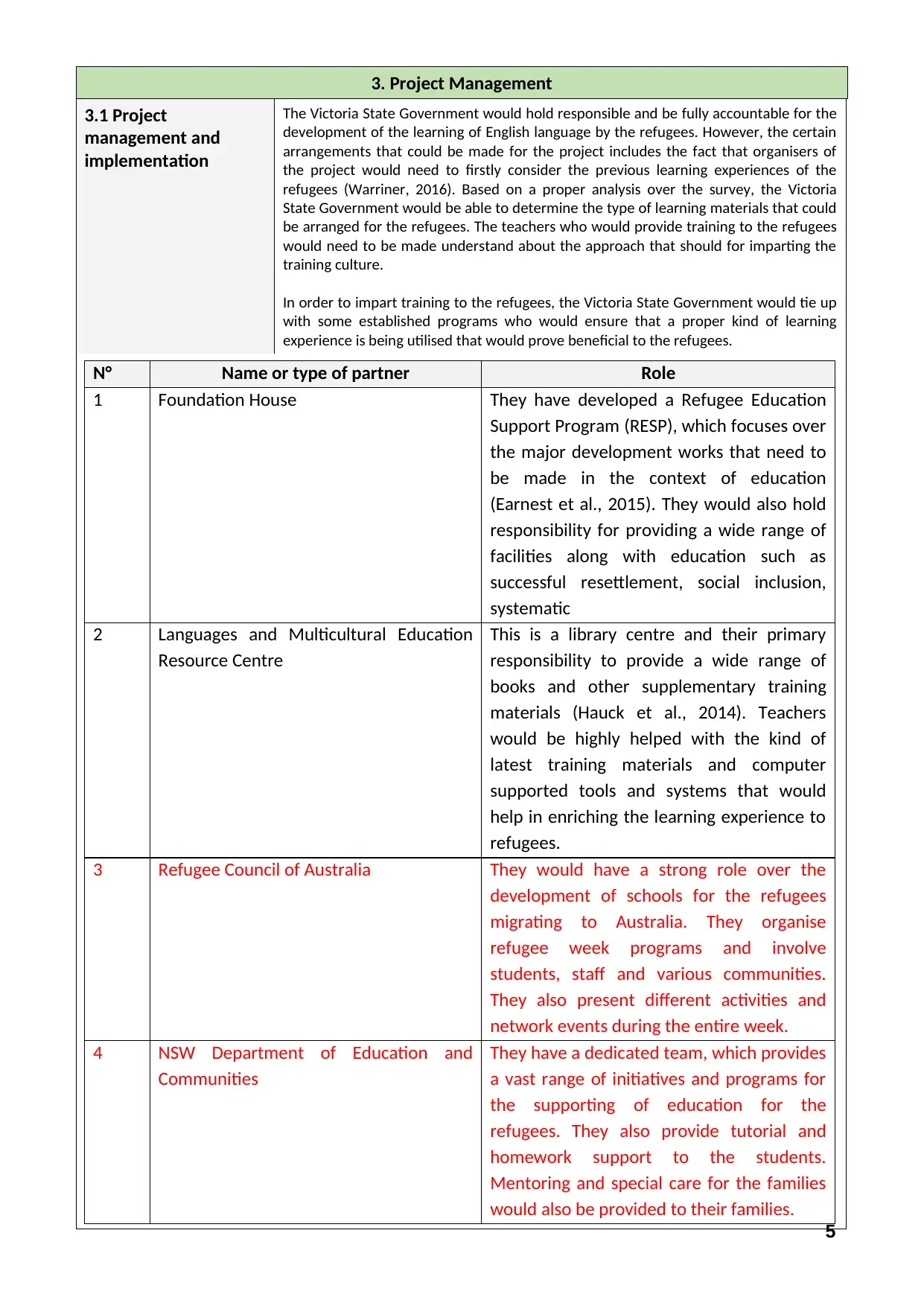
3. Project Management
3.1 Project
management and
implementation
The Victoria State Government would hold responsible and be fully accountable for the
development of the learning of English language by the refugees. However, the certain
arrangements that could be made for the project includes the fact that organisers of
the project would need to firstly consider the previous learning experiences of the
refugees (Warriner, 2016). Based on a proper analysis over the survey, the Victoria
State Government would be able to determine the type of learning materials that could
be arranged for the refugees. The teachers who would provide training to the refugees
would need to be made understand about the approach that should for imparting the
training culture.
In order to impart training to the refugees, the Victoria State Government would tie up
with some established programs who would ensure that a proper kind of learning
experience is being utilised that would prove beneficial to the refugees.
N° Name or type of partner Role
1 Foundation House They have developed a Refugee Education
Support Program (RESP), which focuses over
the major development works that need to
be made in the context of education
(Earnest et al., 2015). They would also hold
responsibility for providing a wide range of
facilities along with education such as
successful resettlement, social inclusion,
systematic
2 Languages and Multicultural Education
Resource Centre
This is a library centre and their primary
responsibility to provide a wide range of
books and other supplementary training
materials (Hauck et al., 2014). Teachers
would be highly helped with the kind of
latest training materials and computer
supported tools and systems that would
help in enriching the learning experience to
refugees.
3 Refugee Council of Australia They would have a strong role over the
development of schools for the refugees
migrating to Australia. They organise
refugee week programs and involve
students, staff and various communities.
They also present different activities and
network events during the entire week.
4 NSW Department of Education and
Communities
They have a dedicated team, which provides
a vast range of initiatives and programs for
the supporting of education for the
refugees. They also provide tutorial and
homework support to the students.
Mentoring and special care for the families
would also be provided to their families.
5
3.1 Project
management and
implementation
The Victoria State Government would hold responsible and be fully accountable for the
development of the learning of English language by the refugees. However, the certain
arrangements that could be made for the project includes the fact that organisers of
the project would need to firstly consider the previous learning experiences of the
refugees (Warriner, 2016). Based on a proper analysis over the survey, the Victoria
State Government would be able to determine the type of learning materials that could
be arranged for the refugees. The teachers who would provide training to the refugees
would need to be made understand about the approach that should for imparting the
training culture.
In order to impart training to the refugees, the Victoria State Government would tie up
with some established programs who would ensure that a proper kind of learning
experience is being utilised that would prove beneficial to the refugees.
N° Name or type of partner Role
1 Foundation House They have developed a Refugee Education
Support Program (RESP), which focuses over
the major development works that need to
be made in the context of education
(Earnest et al., 2015). They would also hold
responsibility for providing a wide range of
facilities along with education such as
successful resettlement, social inclusion,
systematic
2 Languages and Multicultural Education
Resource Centre
This is a library centre and their primary
responsibility to provide a wide range of
books and other supplementary training
materials (Hauck et al., 2014). Teachers
would be highly helped with the kind of
latest training materials and computer
supported tools and systems that would
help in enriching the learning experience to
refugees.
3 Refugee Council of Australia They would have a strong role over the
development of schools for the refugees
migrating to Australia. They organise
refugee week programs and involve
students, staff and various communities.
They also present different activities and
network events during the entire week.
4 NSW Department of Education and
Communities
They have a dedicated team, which provides
a vast range of initiatives and programs for
the supporting of education for the
refugees. They also provide tutorial and
homework support to the students.
Mentoring and special care for the families
would also be provided to their families.
5
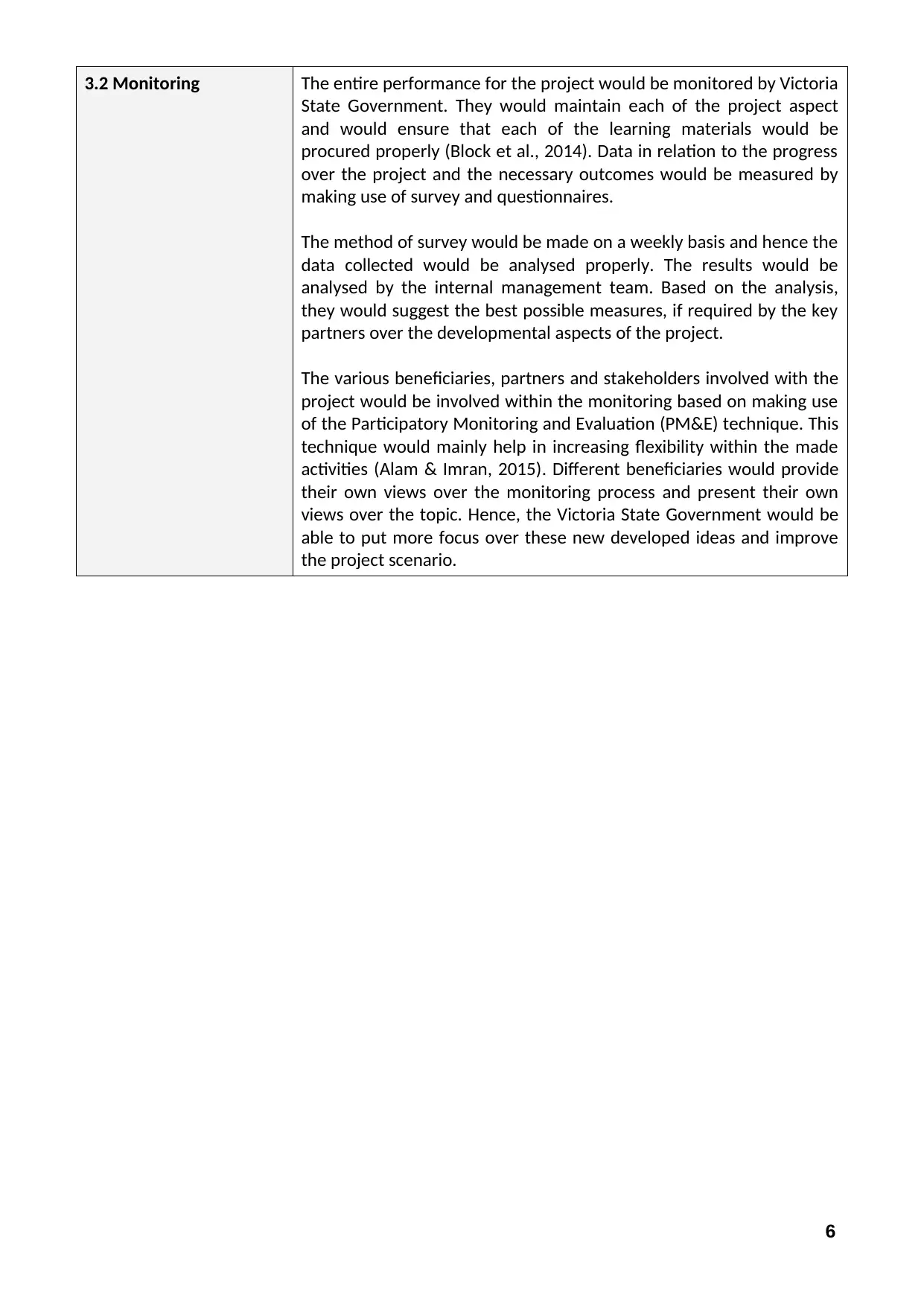
3.2 Monitoring The entire performance for the project would be monitored by Victoria
State Government. They would maintain each of the project aspect
and would ensure that each of the learning materials would be
procured properly (Block et al., 2014). Data in relation to the progress
over the project and the necessary outcomes would be measured by
making use of survey and questionnaires.
The method of survey would be made on a weekly basis and hence the
data collected would be analysed properly. The results would be
analysed by the internal management team. Based on the analysis,
they would suggest the best possible measures, if required by the key
partners over the developmental aspects of the project.
The various beneficiaries, partners and stakeholders involved with the
project would be involved within the monitoring based on making use
of the Participatory Monitoring and Evaluation (PM&E) technique. This
technique would mainly help in increasing flexibility within the made
activities (Alam & Imran, 2015). Different beneficiaries would provide
their own views over the monitoring process and present their own
views over the topic. Hence, the Victoria State Government would be
able to put more focus over these new developed ideas and improve
the project scenario.
6
State Government. They would maintain each of the project aspect
and would ensure that each of the learning materials would be
procured properly (Block et al., 2014). Data in relation to the progress
over the project and the necessary outcomes would be measured by
making use of survey and questionnaires.
The method of survey would be made on a weekly basis and hence the
data collected would be analysed properly. The results would be
analysed by the internal management team. Based on the analysis,
they would suggest the best possible measures, if required by the key
partners over the developmental aspects of the project.
The various beneficiaries, partners and stakeholders involved with the
project would be involved within the monitoring based on making use
of the Participatory Monitoring and Evaluation (PM&E) technique. This
technique would mainly help in increasing flexibility within the made
activities (Alam & Imran, 2015). Different beneficiaries would provide
their own views over the monitoring process and present their own
views over the topic. Hence, the Victoria State Government would be
able to put more focus over these new developed ideas and improve
the project scenario.
6
⊘ This is a preview!⊘
Do you want full access?
Subscribe today to unlock all pages.

Trusted by 1+ million students worldwide
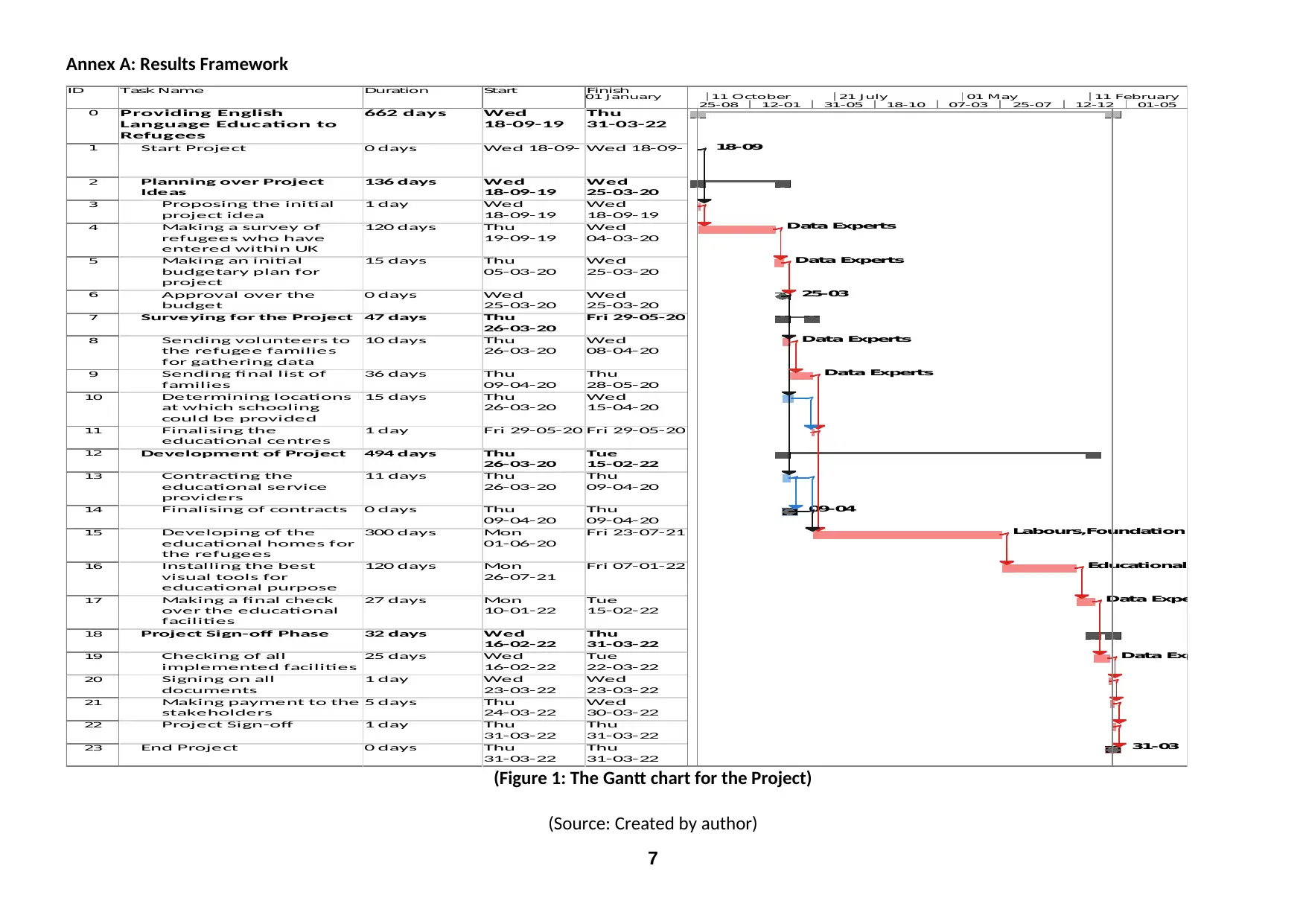
Annex A: Results Framework
ID Task Name Duration Start Finish
0 Providing English
Language Education to
Refugees
662 days Wed
18-09-19
Thu
31-03-22
1 Start Project 0 days Wed 18-09-19Wed 18-09-19
2 Planning over Project
Ideas
136 days Wed
18-09-19
Wed
25-03-20
3 Proposing the initial
project idea
1 day Wed
18-09-19
Wed
18-09-19
4 Making a survey of
refugees who have
entered within UK
120 days Thu
19-09-19
Wed
04-03-20
5 Making an initial
budgetary plan for
project
15 days Thu
05-03-20
Wed
25-03-20
6 Approval over the
budget
0 days Wed
25-03-20
Wed
25-03-20
7 Surveying for the Project 47 days Thu
26-03-20
Fri 29-05-20
8 Sending volunteers to
the refugee families
for gathering data
10 days Thu
26-03-20
Wed
08-04-20
9 Sending final list of
families
36 days Thu
09-04-20
Thu
28-05-20
10 Determining locations
at which schooling
could be provided
15 days Thu
26-03-20
Wed
15-04-20
11 Finalising the
educational centres
1 day Fri 29-05-20 Fri 29-05-20
12 Development of Project 494 days Thu
26-03-20
Tue
15-02-22
13 Contracting the
educational service
providers
11 days Thu
26-03-20
Thu
09-04-20
14 Finalising of contracts 0 days Thu
09-04-20
Thu
09-04-20
15 Developing of the
educational homes for
the refugees
300 days Mon
01-06-20
Fri 23-07-21
16 Installing the best
visual tools for
educational purpose
120 days Mon
26-07-21
Fri 07-01-22
17 Making a final check
over the educational
facilities
27 days Mon
10-01-22
Tue
15-02-22
18 Project Sign-off Phase 32 days Wed
16-02-22
Thu
31-03-22
19 Checking of all
implemented facilities
25 days Wed
16-02-22
Tue
22-03-22
20 Signing on all
documents
1 day Wed
23-03-22
Wed
23-03-22
21 Making payment to the
stakeholders
5 days Thu
24-03-22
Wed
30-03-22
22 Project Sign-off 1 day Thu
31-03-22
Thu
31-03-22
23 End Project 0 days Thu
31-03-22
Thu
31-03-22
18-09
Data Experts
Data Experts
25-03
Data Experts
Data Experts
09-04
Labours,Foundation House,Langua
Educational Materials[1],L
Data Experts
Data Experts,Languag
31-03
25-08 12-01 31-05 18-10 07-03 25-07 12-12 01-05
01 January 11 October 21 July 01 May 11 February
(Figure 1: The Gantt chart for the Project)
(Source: Created by author)
7
ID Task Name Duration Start Finish
0 Providing English
Language Education to
Refugees
662 days Wed
18-09-19
Thu
31-03-22
1 Start Project 0 days Wed 18-09-19Wed 18-09-19
2 Planning over Project
Ideas
136 days Wed
18-09-19
Wed
25-03-20
3 Proposing the initial
project idea
1 day Wed
18-09-19
Wed
18-09-19
4 Making a survey of
refugees who have
entered within UK
120 days Thu
19-09-19
Wed
04-03-20
5 Making an initial
budgetary plan for
project
15 days Thu
05-03-20
Wed
25-03-20
6 Approval over the
budget
0 days Wed
25-03-20
Wed
25-03-20
7 Surveying for the Project 47 days Thu
26-03-20
Fri 29-05-20
8 Sending volunteers to
the refugee families
for gathering data
10 days Thu
26-03-20
Wed
08-04-20
9 Sending final list of
families
36 days Thu
09-04-20
Thu
28-05-20
10 Determining locations
at which schooling
could be provided
15 days Thu
26-03-20
Wed
15-04-20
11 Finalising the
educational centres
1 day Fri 29-05-20 Fri 29-05-20
12 Development of Project 494 days Thu
26-03-20
Tue
15-02-22
13 Contracting the
educational service
providers
11 days Thu
26-03-20
Thu
09-04-20
14 Finalising of contracts 0 days Thu
09-04-20
Thu
09-04-20
15 Developing of the
educational homes for
the refugees
300 days Mon
01-06-20
Fri 23-07-21
16 Installing the best
visual tools for
educational purpose
120 days Mon
26-07-21
Fri 07-01-22
17 Making a final check
over the educational
facilities
27 days Mon
10-01-22
Tue
15-02-22
18 Project Sign-off Phase 32 days Wed
16-02-22
Thu
31-03-22
19 Checking of all
implemented facilities
25 days Wed
16-02-22
Tue
22-03-22
20 Signing on all
documents
1 day Wed
23-03-22
Wed
23-03-22
21 Making payment to the
stakeholders
5 days Thu
24-03-22
Wed
30-03-22
22 Project Sign-off 1 day Thu
31-03-22
Thu
31-03-22
23 End Project 0 days Thu
31-03-22
Thu
31-03-22
18-09
Data Experts
Data Experts
25-03
Data Experts
Data Experts
09-04
Labours,Foundation House,Langua
Educational Materials[1],L
Data Experts
Data Experts,Languag
31-03
25-08 12-01 31-05 18-10 07-03 25-07 12-12 01-05
01 January 11 October 21 July 01 May 11 February
(Figure 1: The Gantt chart for the Project)
(Source: Created by author)
7
Paraphrase This Document
Need a fresh take? Get an instant paraphrase of this document with our AI Paraphraser

Annex B: Timeline (with examples)
Key Activities Months/or quarters
1 2 3 4 5 6 7 8 9 10
Planning over Project Ideas XXX XXX XXX XXX
Surveying for the Project XXX
Development of Project XXX XXX XXX XXX XXX XXX
Project Sign-off Phase XXX
8
Key Activities Months/or quarters
1 2 3 4 5 6 7 8 9 10
Planning over Project Ideas XXX XXX XXX XXX
Surveying for the Project XXX
Development of Project XXX XXX XXX XXX XXX XXX
Project Sign-off Phase XXX
8
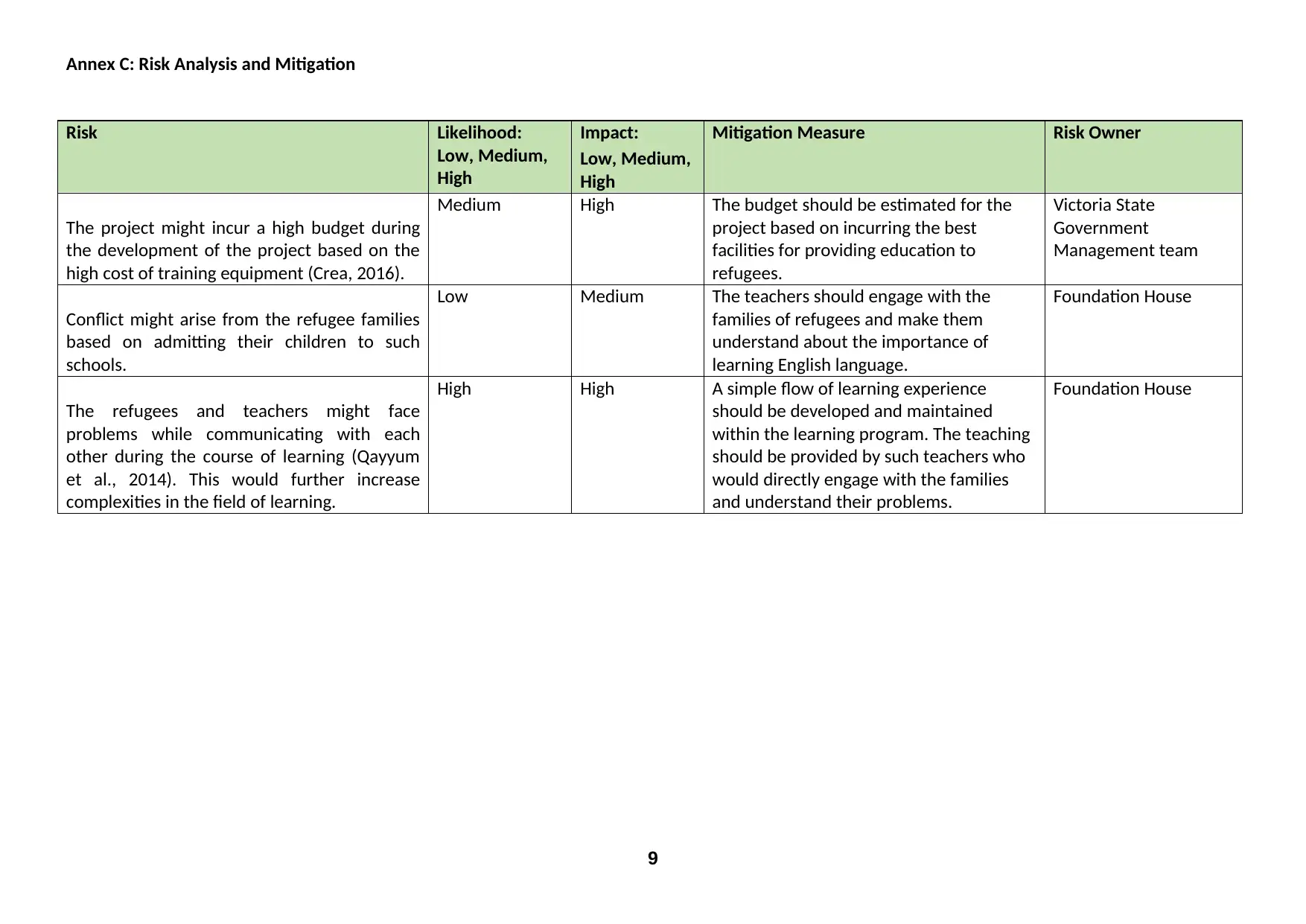
Annex C: Risk Analysis and Mitigation
Risk Likelihood:
Low, Medium,
High
Impact:
Low, Medium,
High
Mitigation Measure Risk Owner
The project might incur a high budget during
the development of the project based on the
high cost of training equipment (Crea, 2016).
Medium High The budget should be estimated for the
project based on incurring the best
facilities for providing education to
refugees.
Victoria State
Government
Management team
Conflict might arise from the refugee families
based on admitting their children to such
schools.
Low Medium The teachers should engage with the
families of refugees and make them
understand about the importance of
learning English language.
Foundation House
The refugees and teachers might face
problems while communicating with each
other during the course of learning (Qayyum
et al., 2014). This would further increase
complexities in the field of learning.
High High A simple flow of learning experience
should be developed and maintained
within the learning program. The teaching
should be provided by such teachers who
would directly engage with the families
and understand their problems.
Foundation House
9
Risk Likelihood:
Low, Medium,
High
Impact:
Low, Medium,
High
Mitigation Measure Risk Owner
The project might incur a high budget during
the development of the project based on the
high cost of training equipment (Crea, 2016).
Medium High The budget should be estimated for the
project based on incurring the best
facilities for providing education to
refugees.
Victoria State
Government
Management team
Conflict might arise from the refugee families
based on admitting their children to such
schools.
Low Medium The teachers should engage with the
families of refugees and make them
understand about the importance of
learning English language.
Foundation House
The refugees and teachers might face
problems while communicating with each
other during the course of learning (Qayyum
et al., 2014). This would further increase
complexities in the field of learning.
High High A simple flow of learning experience
should be developed and maintained
within the learning program. The teaching
should be provided by such teachers who
would directly engage with the families
and understand their problems.
Foundation House
9
⊘ This is a preview!⊘
Do you want full access?
Subscribe today to unlock all pages.

Trusted by 1+ million students worldwide
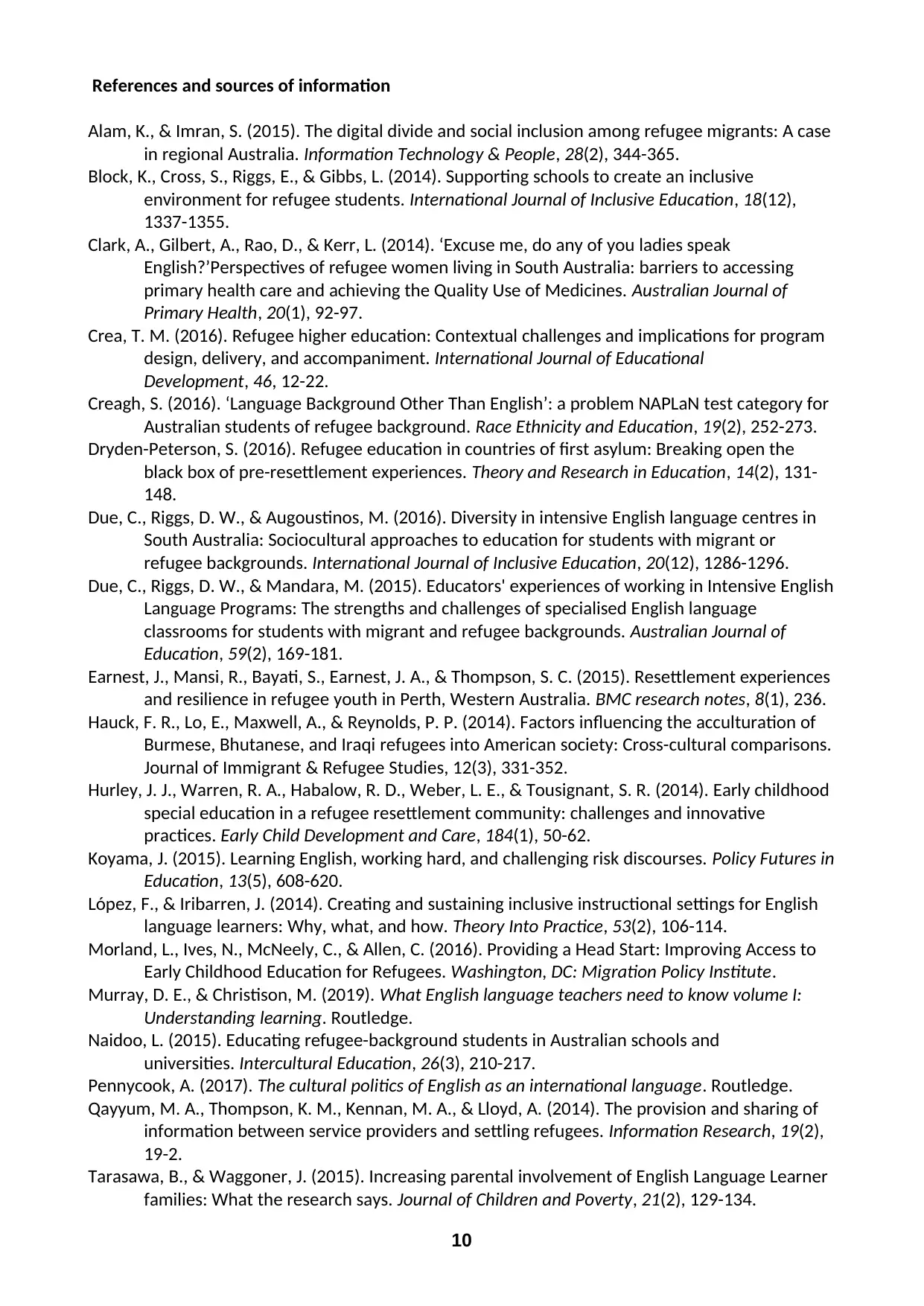
References and sources of information
Alam, K., & Imran, S. (2015). The digital divide and social inclusion among refugee migrants: A case
in regional Australia. Information Technology & People, 28(2), 344-365.
Block, K., Cross, S., Riggs, E., & Gibbs, L. (2014). Supporting schools to create an inclusive
environment for refugee students. International Journal of Inclusive Education, 18(12),
1337-1355.
Clark, A., Gilbert, A., Rao, D., & Kerr, L. (2014). ‘Excuse me, do any of you ladies speak
English?’Perspectives of refugee women living in South Australia: barriers to accessing
primary health care and achieving the Quality Use of Medicines. Australian Journal of
Primary Health, 20(1), 92-97.
Crea, T. M. (2016). Refugee higher education: Contextual challenges and implications for program
design, delivery, and accompaniment. International Journal of Educational
Development, 46, 12-22.
Creagh, S. (2016). ‘Language Background Other Than English’: a problem NAPLaN test category for
Australian students of refugee background. Race Ethnicity and Education, 19(2), 252-273.
Dryden-Peterson, S. (2016). Refugee education in countries of first asylum: Breaking open the
black box of pre-resettlement experiences. Theory and Research in Education, 14(2), 131-
148.
Due, C., Riggs, D. W., & Augoustinos, M. (2016). Diversity in intensive English language centres in
South Australia: Sociocultural approaches to education for students with migrant or
refugee backgrounds. International Journal of Inclusive Education, 20(12), 1286-1296.
Due, C., Riggs, D. W., & Mandara, M. (2015). Educators' experiences of working in Intensive English
Language Programs: The strengths and challenges of specialised English language
classrooms for students with migrant and refugee backgrounds. Australian Journal of
Education, 59(2), 169-181.
Earnest, J., Mansi, R., Bayati, S., Earnest, J. A., & Thompson, S. C. (2015). Resettlement experiences
and resilience in refugee youth in Perth, Western Australia. BMC research notes, 8(1), 236.
Hauck, F. R., Lo, E., Maxwell, A., & Reynolds, P. P. (2014). Factors influencing the acculturation of
Burmese, Bhutanese, and Iraqi refugees into American society: Cross-cultural comparisons.
Journal of Immigrant & Refugee Studies, 12(3), 331-352.
Hurley, J. J., Warren, R. A., Habalow, R. D., Weber, L. E., & Tousignant, S. R. (2014). Early childhood
special education in a refugee resettlement community: challenges and innovative
practices. Early Child Development and Care, 184(1), 50-62.
Koyama, J. (2015). Learning English, working hard, and challenging risk discourses. Policy Futures in
Education, 13(5), 608-620.
López, F., & Iribarren, J. (2014). Creating and sustaining inclusive instructional settings for English
language learners: Why, what, and how. Theory Into Practice, 53(2), 106-114.
Morland, L., Ives, N., McNeely, C., & Allen, C. (2016). Providing a Head Start: Improving Access to
Early Childhood Education for Refugees. Washington, DC: Migration Policy Institute.
Murray, D. E., & Christison, M. (2019). What English language teachers need to know volume I:
Understanding learning. Routledge.
Naidoo, L. (2015). Educating refugee-background students in Australian schools and
universities. Intercultural Education, 26(3), 210-217.
Pennycook, A. (2017). The cultural politics of English as an international language. Routledge.
Qayyum, M. A., Thompson, K. M., Kennan, M. A., & Lloyd, A. (2014). The provision and sharing of
information between service providers and settling refugees. Information Research, 19(2),
19-2.
Tarasawa, B., & Waggoner, J. (2015). Increasing parental involvement of English Language Learner
families: What the research says. Journal of Children and Poverty, 21(2), 129-134.
10
Alam, K., & Imran, S. (2015). The digital divide and social inclusion among refugee migrants: A case
in regional Australia. Information Technology & People, 28(2), 344-365.
Block, K., Cross, S., Riggs, E., & Gibbs, L. (2014). Supporting schools to create an inclusive
environment for refugee students. International Journal of Inclusive Education, 18(12),
1337-1355.
Clark, A., Gilbert, A., Rao, D., & Kerr, L. (2014). ‘Excuse me, do any of you ladies speak
English?’Perspectives of refugee women living in South Australia: barriers to accessing
primary health care and achieving the Quality Use of Medicines. Australian Journal of
Primary Health, 20(1), 92-97.
Crea, T. M. (2016). Refugee higher education: Contextual challenges and implications for program
design, delivery, and accompaniment. International Journal of Educational
Development, 46, 12-22.
Creagh, S. (2016). ‘Language Background Other Than English’: a problem NAPLaN test category for
Australian students of refugee background. Race Ethnicity and Education, 19(2), 252-273.
Dryden-Peterson, S. (2016). Refugee education in countries of first asylum: Breaking open the
black box of pre-resettlement experiences. Theory and Research in Education, 14(2), 131-
148.
Due, C., Riggs, D. W., & Augoustinos, M. (2016). Diversity in intensive English language centres in
South Australia: Sociocultural approaches to education for students with migrant or
refugee backgrounds. International Journal of Inclusive Education, 20(12), 1286-1296.
Due, C., Riggs, D. W., & Mandara, M. (2015). Educators' experiences of working in Intensive English
Language Programs: The strengths and challenges of specialised English language
classrooms for students with migrant and refugee backgrounds. Australian Journal of
Education, 59(2), 169-181.
Earnest, J., Mansi, R., Bayati, S., Earnest, J. A., & Thompson, S. C. (2015). Resettlement experiences
and resilience in refugee youth in Perth, Western Australia. BMC research notes, 8(1), 236.
Hauck, F. R., Lo, E., Maxwell, A., & Reynolds, P. P. (2014). Factors influencing the acculturation of
Burmese, Bhutanese, and Iraqi refugees into American society: Cross-cultural comparisons.
Journal of Immigrant & Refugee Studies, 12(3), 331-352.
Hurley, J. J., Warren, R. A., Habalow, R. D., Weber, L. E., & Tousignant, S. R. (2014). Early childhood
special education in a refugee resettlement community: challenges and innovative
practices. Early Child Development and Care, 184(1), 50-62.
Koyama, J. (2015). Learning English, working hard, and challenging risk discourses. Policy Futures in
Education, 13(5), 608-620.
López, F., & Iribarren, J. (2014). Creating and sustaining inclusive instructional settings for English
language learners: Why, what, and how. Theory Into Practice, 53(2), 106-114.
Morland, L., Ives, N., McNeely, C., & Allen, C. (2016). Providing a Head Start: Improving Access to
Early Childhood Education for Refugees. Washington, DC: Migration Policy Institute.
Murray, D. E., & Christison, M. (2019). What English language teachers need to know volume I:
Understanding learning. Routledge.
Naidoo, L. (2015). Educating refugee-background students in Australian schools and
universities. Intercultural Education, 26(3), 210-217.
Pennycook, A. (2017). The cultural politics of English as an international language. Routledge.
Qayyum, M. A., Thompson, K. M., Kennan, M. A., & Lloyd, A. (2014). The provision and sharing of
information between service providers and settling refugees. Information Research, 19(2),
19-2.
Tarasawa, B., & Waggoner, J. (2015). Increasing parental involvement of English Language Learner
families: What the research says. Journal of Children and Poverty, 21(2), 129-134.
10
Paraphrase This Document
Need a fresh take? Get an instant paraphrase of this document with our AI Paraphraser

Warriner, D. S. (2016). ‘Here, without English, you are dead’: ideologies of language and discourses
of neoliberalism in adult English language learning. Journal of Multilingual and
Multicultural Development, 37(5), 495-508.
11
of neoliberalism in adult English language learning. Journal of Multilingual and
Multicultural Development, 37(5), 495-508.
11
1 out of 11
Related Documents
Your All-in-One AI-Powered Toolkit for Academic Success.
+13062052269
info@desklib.com
Available 24*7 on WhatsApp / Email
![[object Object]](/_next/static/media/star-bottom.7253800d.svg)
Unlock your academic potential
Copyright © 2020–2025 A2Z Services. All Rights Reserved. Developed and managed by ZUCOL.





